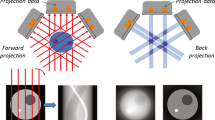Abstract
A sub-voxel digital volume correlation (DVC) method combining the 3D inverse compositional Gauss-Newton (ICGN) algorithm with the 3D fast Fourier transform-based cross correlation (FFT-CC) algorithm is proposed to eliminate path-dependence in current iterative DVC methods caused by the initial guess transfer scheme. The proposed path-independent DVC method is implemented on NVIDIA compute unified device architecture (CUDA) for GPU devices. Powered by parallel computing technology, the proposed DVC method achieves a significant improvement in computation speed on a common desktop computer equipped with a low-end graphics card containing 1536 CUDA cores, i.e., up to 23.3 times faster than the sequential implementation and 3.7 times faster than the multithreaded implementation of the same DVC method running on a 6-core CPU. This speedup, which has no compromise with resolution, accuracy and precision, benefits from the coarse-grained parallelism that the points of interest (POIs) are processed simultaneously and also from the fine-grained parallelism that the calculation at each POI is performed with multiple threads in GPU. The experimental study demonstrates the superiority of the GPU-based parallel computing for acceleration of DVC over the multi-core CPU-based one, in particular on a PC level computer.










Similar content being viewed by others
References
Bay BK, Smith TS, Fyhrie DP, Saad M (1999) Digital volume correlation: three-dimensional strain mapping using X-ray tomography. Exp Mech 39(3):217–226
Smith TS, Bay BK, Rashid MM (2002) Digital volume correlation including rotational degrees of freedom during minimization. Exp Mech 42(3):272–278
Peters WH, Ranson WF (1982) Digital imaging techniques in experimental stress analysis. Opt Eng 21(3):427–431
Sutton MA, Orteu JJ, Schreier H (2009) Image correlation for shape, motion and deformation measurements: basic concepts, theory and applications. Springer, New York
Zauel R, Yeni Y, Bay B, Dong X, Fyhrie D (2006) Comparison of the linear finite element prediction of deformation and strain of human cancellous bone to 3D digital volume correlation measurements. J Biomech Eng 128(1):1–6
Franck C, Hong S, Maskarinec S, Tirrell D, Ravichandran G (2007) Three-dimensional full-field measurements of large deformations in soft materials using confocal microscopy and digital volume correlation. Exp Mech 47(3):427–438
Huang J, Pan X, Li S, Peng X, Xiong C, Fang J (2011) A digital volume correlation technique for 3-D deformation measurements of soft gels. Int J Appl Mech 3(2):335–354
Forsberg F, Sjödahl M, Mooser R, Hack E, Wyss P (2010) Full three-dimensional strain measurements on wood exposed to three-point bending: analysis by use of digital volume correlation applied to synchrotron radiation micro-computed tomography image data. Strain 46(1):47–60
Hall S, Bornert M, Desrues J, Pannier Y, Lenoir N, Viggiani G, Bésuelle P (2010) Discrete and continuum analysis of localised deformation in sand using X-ray μCT and volumetric digital image correlation. Geotechnique 60(5):315–322
Gates M, Heath MT, Lambros J (2015) High-performance hybrid CPU and GPU parallel algorithm for digital volume correlation. Int J High Perform Comput Appl 29(1):92–106
Gates M, Lambros J, Heath M (2011) Towards high performance digital volume correlation. Exp Mech 51(4):491–507
Pan B, Wu D, Wang Z (2012) Internal displacement and strain measurement using digital volume correlation: a least-squares framework. Meas Sci Technol 23(4):045002
Pan B, Wang B, Wu D, Lubineau G (2014) An efficient and accurate 3D displacements tracking strategy for digital volume correlation. Opt Laser Eng 58:126–135
Baker S, Matthews I (2004) Lucas-kanade 20 years on: a unifying framework. Int J Comput Vision 56(3):221–255
Pan B (2009) Reliability-guided digital image correlation for image deformation measurement. Appl Optics 48(8):1535–1542
Pan B, Li K (2011) A fast digital image correlation method for deformation measurement. Opt Laser Eng 49(7):841–847
Jiang Z, Kemao Q, Miao H, Yang J, Tang L (2015) Path-independent digital image correlation with high accuracy, speed and robustness. Opt Laser Eng 65:93–102
Zhang L, Wang T, Jiang Z, Kemao Q, Liu Y, Liu Z, Tang L, Dong S (2015) High accuracy digital image correlation powered by GPU-based parallel computing. Opt Laser Eng 69:7–12
Bar-Kochba E, Toyjanova J, Andrews E, Kim K-S, Franck C (2015) A fast iterative digital volume correlation algorithm for large deformations. Exp Mech 55(1):261–274
Leclerc H, Périé J-N, Hild F, Roux S (2012) Digital volume correlation: what are the limits to the spatial resolution? Mechanics Industry 13(6):361–371
Schreier HW, Braasch JR, Sutton MA (2000) Systematic errors in digital image correlation caused by intensity interpolation. Opt Eng 39(11):2915–2921
Pan B, Xie H, Xu B, Dai F (2006) Performance of sub-pixel registration algorithms in digital image correlation. Meas Sci Technol 17(6):1615–1621
Pan B (2013) Bias error reduction of digital image correlation using Gaussian pre-filtering. Opt Laser Eng 51(10):1161–1167
Iwamura M, Hondo T, Noguchi K, Kise K (2007) An attempt of CUDA implementation of PCA-SIFT (International Session 6). Technical Report IEICE PRMU 107(281):149–154
Cook S (2013) CUDA programming: a developer’s guide to parallel computing with GPUs. Applications of GPU Computing. Morgan Kaufmann, Waltham
Frigo M, Johnson SG (2005) The design and implementation of FFTW3. Proc IEEE 93(2):216–231
Acknowledgments
The work is partially supported by a grant, MOE2011-T2-2-037 (ARC 4/12), Ministry of Education, Singapore, the Multi-plAtform Game Innovation Centre (MAGIC) funded by the Singapore National Research Foundation under its IDM Futures Funding Initiative and administered by the Interactive & Digital Media Programme Office, Media Development Authority, and National Natural Science Foundation of China (NSFC Nos. 11202081 and 11272124). Z Jiang would acknowledge the support of the Project sponsored by the Scientific Research Foundation for the Returned Overseas Chinese Scholars, State Education Ministry.
Author information
Authors and Affiliations
Corresponding authors
Rights and permissions
About this article
Cite this article
Wang, T., Jiang, Z., Kemao, Q. et al. GPU Accelerated Digital Volume Correlation. Exp Mech 56, 297–309 (2016). https://doi.org/10.1007/s11340-015-0091-4
Received:
Accepted:
Published:
Issue Date:
DOI: https://doi.org/10.1007/s11340-015-0091-4




